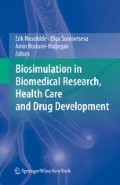Abstract
Transport by diffusion is an efficient process on very short distances only. Any organism above a certain (small) size therefore requires some kind of circulatory system that can deliver nutrients to the tissues and can clear out waste products. The circulatory system has a diversity of designs in the animal kingdom. In most cases however, an exchange medium, i.e. the blood, is physically circulated and brought into contact with every part of every tissue in the body in order for the basic process of exchange between blood and tissue to proceed efficiently. This exchange process primarily takes place in the smallest vessels of the microcirculation, the capillaries. The density of these vessels in a given tissue reflects its basal metabolic activity such that high densities and, hence, potentially high exchange rates, are found in tissues with high metabolic activity, e.g. the kidneys and the heart. At the other extreme are avascular tissues such as the cartilage of the joints. Such tissues seem to rely on diffusion over long distances and they are characterized by very low metabolic activity. In a given tissue, capillarity may also change with long-term changes in average metabolic activity as it has been observed in endurance trained skeletal muscles [8].
Access this chapter
Tax calculation will be finalised at checkout
Purchases are for personal use only
References
Bakker EN, Buus CL, VanBavel E, Mulvany MJ (2004) Activation of resistance arteries with endothelin-1: from vasoconstriction to functional adaptation and remodeling. J Vasc Res 41:174–182
Bakker EN, Sorop O, Spaan JA, VanBavel E (2004) Remodeling of resistance arteries in organoid culture is modulated by pressure and pressure pulsation and depends on vasomotion. Am J Physiol Heart Circ Physiol 286:H2052–H2056
Bakker EN, van der Meulen ET, van den Berg BM, Everts V, Spaan JA, VanBavel E (2002) Inward remodeling follows chronic vasoconstriction in isolated resistance arteries. J Vasc Res 39:12–20
Burkitt HG, Young B, Heath JW (1993) Functional Histology. Edinburgh: Churchill Livingstone
Cornelissen AJ, Dankelman J, VanBavel E, Spaan JA (2002) Balance between myogenic, flow-dependent, and metabolic flow control in coronary arterial tree: a model study. Am J Physiol Heart Circ Physiol 282:H2224–H2237
Davis MJ, Hill MA (1999) Signaling mechanisms underlying the vascular myogenic response. Physiol Rev 79:387–423
Frasher WG Jr, Wayland HA (1972) Repeating modular organization of the microcirculation of cat mesentery. Microvasc Res 4:62–76
Gute D, Fraga C, Laughlin MH, Amann JF (1996) Regional changes in capillary supply in skeletal muscle of high-intensity endurance-trained rats. J Appl Physiol 81:619–626
Jacobsen JC, Gustafsson F, Holstein-Rathlou NH (2003) A model of physical factors in the structural adaptation of microvascular networks in normotension and hypertension. Physiol Meas 24:891–912
Jacobsen JC, Hornbech MS, Holstein-Rathlou NH (2009) A tissue in the tissue: models of microvascular plasticity. Eur J Pharm Sci 36:51–61
Jacobsen, JC, Hornbech, MS, Holstein-Rathlou N-H (2011) Significance of microvascular remodeling for the vascular flow reserve in hypertension. Interface Focus 1:1:117–131
Jacobsen JC, Mulvany MJ, Holstein-Rathlou NH (2008) A mechanism for arteriolar remodeling based on maintenance of smooth muscle cell activation. Am J Physiol Regul Integr Comp Physiol 294:R1379–R1389
Koller A, Sun D, Huang A, Kaley G (1994) Corelease of nitric oxide and prostaglandins mediates flow-dependent dilation of rat gracilis muscle arterioles. Am J Physiol 267:H326–H332
Lipowsky HH, Zweifach BW (1974) Network analysis of microcirculation of cat mesentery. Microvasc Res 7:73–83
Martinez-Lemus LA, Hill MA, Bolz SS, Pohl U, Meininger GA (2004) Acute mechanoadaptation of vascular smooth muscle cells in response to continuous arteriolar vasoconstriction: implications for functional remodeling. FASEB J 18:708–710
Mosekilde Li (1988) Age-related changes in vertebral trabecular bone architecture - assessed by a new method. Bone 9:4:247–250
Mulvany MJ (2008) Small artery remodelling in hypertension: causes, consequences and therapeutic implications. Med Biol Eng Comput 46:461–467
Pries AR, Reglin B, Secomb TW (2005) Remodeling of blood vessels: responses of diameter and wall thickness to hemodynamic and metabolic stimuli. Hypertension 46:725–731
Pries AR, Secomb TW, Gaehtgens P (1998) Structural adaptation and stability of microvascular networks: theory and simulations. Am J Physiol 275:H349–H360
Rachev A, Stergiopulos N, Meister JJ (1998) A model for geometric and mechanical adaptation of arteries to sustained hypertension. J Biomech Eng 120:9–17
Sorop O, Bakker EN, Pistea A, Spaan JA, VanBavel E (2006) Calcium channel blockade prevents pressure-dependent inward remodeling in isolated subendocardial resistance vessels. Am J Physiol Heart Circ Physiol 291:H1236–H1245
VanBavel E, Bakker EN, Pistea A, Sorop O, Spaan JA (2006) Mechanics of microvascular remodeling. Clin Hemorheol Microcirc 34:35–41
Author information
Authors and Affiliations
Corresponding author
Editor information
Editors and Affiliations
Rights and permissions
Copyright information
© 2011 Springer-Verlag/Wien
About this chapter
Cite this chapter
Jacobsen, J.C.B., Olesen, N.E., Holstein-Rathlou, NH. (2011). Microvascular Plasticity. In: Mosekilde, E., Sosnovtseva, O., Rostami-Hodjegan, A. (eds) Biosimulation in Biomedical Research, Health Care and Drug Development. Springer, Vienna. https://doi.org/10.1007/978-3-7091-0418-7_11
Download citation
DOI: https://doi.org/10.1007/978-3-7091-0418-7_11
Published:
Publisher Name: Springer, Vienna
Print ISBN: 978-3-7091-0417-0
Online ISBN: 978-3-7091-0418-7
eBook Packages: Biomedical and Life SciencesBiomedical and Life Sciences (R0)

